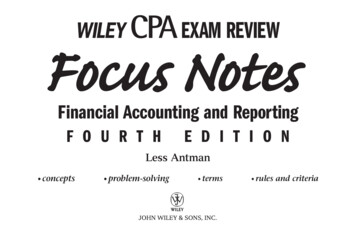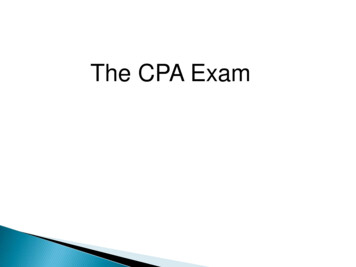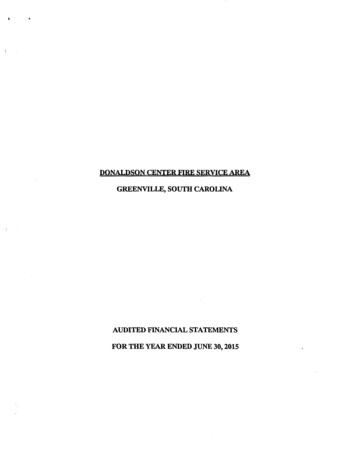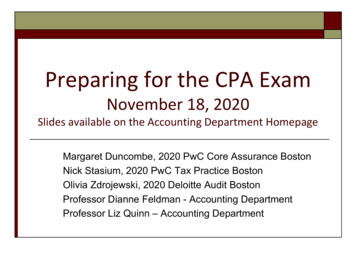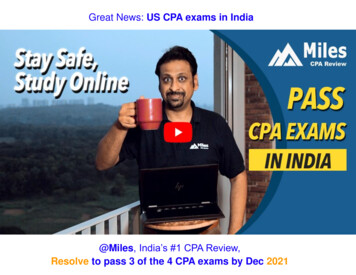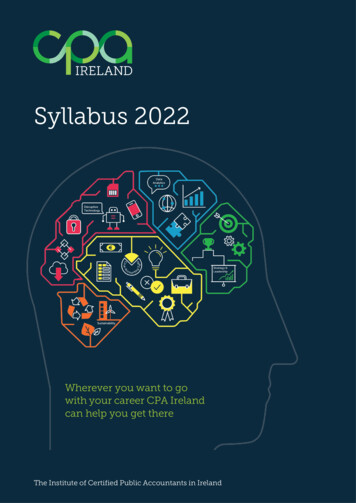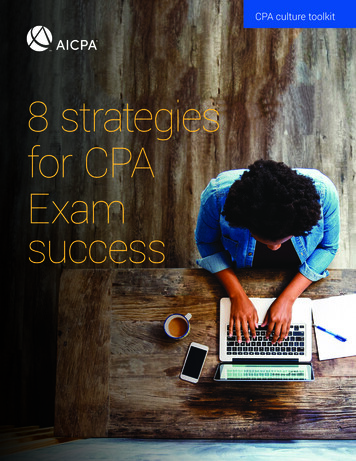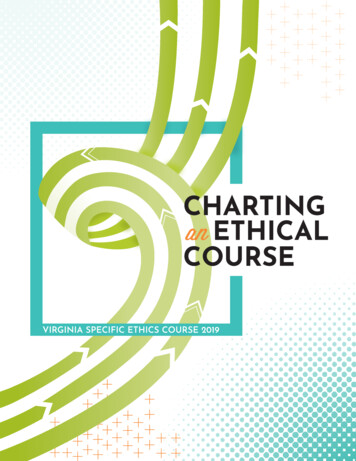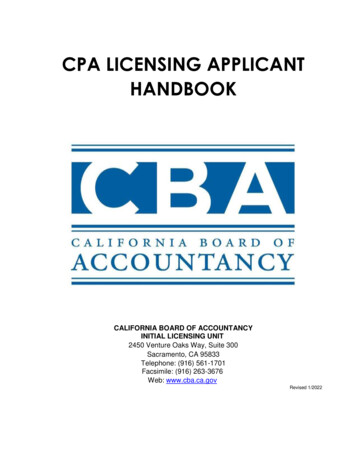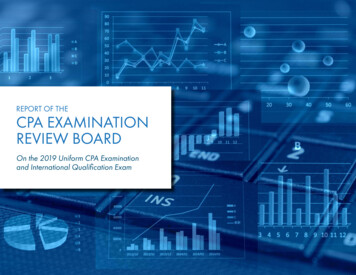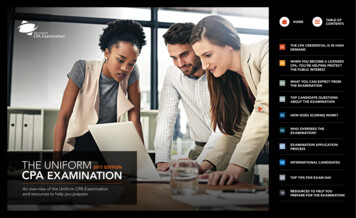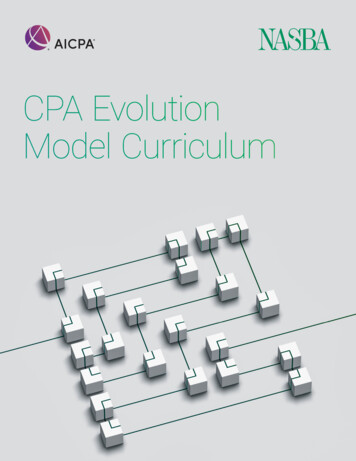
Transcription
CPA EvolutionModel Curriculum
Disclaimer: The contents of this publication do not necessarily reflect the position or opinion of the American Institute ofCPAs (AICPA), its divisions and its committees, and do not necessarily reflect the position or opinion of the National Associationof State Boards of Accountancy (NASBA), its divisions and its committees. This publication is designed to provide accurate andauthoritative information on the subject covered. It is distributed with the understanding that the authors are not engaged inrendering legal, accounting or other professional services. If legal advice or other expert assistance is required, the servicesof a competent professional should be sought.For more information about the procedure for requesting permission to make copies of any part of this work, please emailcopyright@aicpa.org with your request. Otherwise, requests should be written and mailed to the Permissions Department,AICPA, 220 Leigh Farm Road, Durham, NC 27707–8110.
Contents3Introduction6Information and Instructions for Use of CPA Evolution Model Curriculum8Part I: CPA Evolution Core8 Section 1: Accounting and Data Analytics Core8101416161819192122Section 2: Audit and Accounting Information Systems Core22242629303132333435373839414142Module 1: Financial StatementsModule 2: Select Financial Statement AccountsModule 3: Select Financial Statement Transactions and EventsModule 4: Financial Statement Analysis and MetricsModule 5: Financial Statements and Select Transactions for Not-For-Profit (NFP) EntitiesModule 6: Financial Statements and Select Transactions for State and Local GovernmentsModule 7: Critical ThinkingModule 8: Financial Data AnalyticsModule 9: Digital AcumenModule 1: Audit EnvironmentModule 2: Engagement Planning and ConsiderationsModule 3: Understanding an Entity and its EnvironmentModule 4: Information TechnologyModule 5: Risk Assessment of Fraud and NoncomplianceModule 6: Assessing Risk of Material MisstatementModule 7: MaterialityModule 8: Audit EvidenceModule 9: Audit ProceduresModule 10: Special ConsiderationsModule 11: Audit ConclusionModule 12: Audit ReportsModule 13: Other EngagementsModule 14: Subsequent Events and Subsequently Discovered FactsModule 15: Digital AcumenSection 3: Tax Core424242434445474849505051Module 1: Responsibilities in Tax PracticeModule 2: Methods of TaxationModule 3: Federal Tax ProceduresModule 4: Legal Duties and ResponsibilitiesModule 5: Acquisition and Disposition of AssetsModule 6: Federal Taxation of IndividualsModule 7: C CorporationsModule 8: S CorporationsModule 9: PartnershipsModule 10: Limited Liability CompaniesModule 11: Tax-Exempt OrganizationsModule 12: Technology and Digital Acumen1 CPA Evolution Model Curriculum
52 Part II: CPA Evolution Discipline52Section 1: Business Analysis and Reporting (BAR) Discipline5252535456576060616266Section 2: Information Systems and Controls (ISC) Discipline666970717273Module 1: Accounting ResearchModule 2: For-Profit Entity Financial StatementsModule 3: Select Financial Statement AccountsModule 4: Select TransactionsModule 5: Cost accountingModule 6: State and Local GovernmentsModule 7: Employee Benefit Plan AccountingModule 8: Planning TechniquesModule 9: Financial Statement AnalysisModule 10: Advanced Data AnalyticsModule 1: IT Governance and Risk AssessmentModule 2: Performing Procedures, Tests of Internal ControlsModule 3: SOC EngagementsModule 4: Use and Management of DataModule 5: Information Security and Protection of Information AssetsSection 3: Tax Compliance and Planning (TCP) Discipline7375767778798083848585868687Module 1: Individual Tax Fundamentals and Tax PlanningModule 2: Acquisition, Use and Disposition of AssetsModule 3: Tax Accounting MethodsModule 4: Federal Taxation of EntitiesModule 5: C CorporationsModule 6: S CorporationsModule 7: PartnershipsModule 8: Tax Planning for EntitiesModule 9: TrustsModule 10: Tax-Exempt OrganizationsModule 11: Multijurisdictional Tax BasicsModule 12: TechnologyModule 13: Tax ResearchModule 14: Personal Financial Advisory Services89 Appendix89Illustrative Accounting Program Structures for Future CPAs2 CPA Evolution Model Curriculum
IntroductionThank you for your interest in the AICPA’s and NASBA’s CPA Evolution Model Curriculum. Itwas developed to assist faculty who want to prepare their students for the CPA profession.It is materially aligned with the Uniform Accountancy Act Model Rules for education and reflectsinsights gathered through the 2021 CPA Exam Practice Analysis as well as the views of thesubject matter experts who served on the CPA Evolution Model Curriculum Task Forces.The Task Forces were comprised of over 40 volunteers, including faculty from small schools andlarge universities, CPAs in public practice, business and industry and representatives from stateboards of accountancy. The Task Forces met over 50 times over the course of six months. TheAICPA and NASBA would like to extend our gratitude to the Task Forces – they worked tirelesslyto produce a curriculum that is reflective of the practice environment, volunteering dozens ofhours of their time.The CPA Evolution Model Curriculum is comprised of two main components: (1) detailed contentsuggestions split into two parts comprised of three sections each with multiple modules, topics,and learning objectives and (2) examples of course structuring. This CPA-oriented curriculumis an example, developed at the request of accounting faculty, to provide insight into how anaccounting program might transition in light of CPA Evolution.The role of today’s CPA has evolved. Newly licensed CPAs need deeper skill sets, morecompetencies and greater knowledge of emerging technologies. That’s why the CPA licensuremodel is changing. The CPA Evolution initiative, a joint project between the AICPA and NASBA,aims to transform the CPA licensure model to recognize the rapidly changing skills andcompetencies the practice of accounting requires today and will require in the future. AspiringCPAs who are college freshmen today will be among the first to take the updated version of theUniform CPA Examination when it launches in 2024.Accounting educators will play a vital role in preparing students to pursue the CPA license underthis new model. We developed the CPA Evolution Model Curriculum as one example of how anaccounting program might transition to reflect the new Core Disciplines, CPA licensure model.When targeting our efforts in developing the curriculum, we elected to focus on a university’saccounting curriculum that is relevant to preparing future CPAs, except for principles ofaccounting courses, which are often built into a university’s business pre-requisite curriculum.This means that independent of the content recommended through the CPA Evolution ModelCurriculum, it is presumed that students will complete coursework in principles of financialaccounting and principles of managerial accounting, as well as relevant business courses suchas economics, finance and business law.Part 1 of this CPA Evolution Model Curriculum covers the content necessary for all future CPAs,regardless of their chosen discipline and Part 2 covers the content relevant for each of the threeseparate disciplines. The CPA Evolution Model Curriculum, however, does not specify whethercontent should be covered at an undergraduate or graduate level, as this decision will differbased on the circumstances of each accounting program. Leveraging feedback from the facultyon the Task Forces, we have provided suggested courses where the content might be taught aswell as instructional time estimates for each topic, however, these are provided for reference only.We recognize that the courses chosen and time devoted by a program to present these topics areentirely at the program’s discretion.3 CPA Evolution Model Curriculum
Based on these data points, we believe we have developed a curriculum that is actionablefor faculty at programs of all sizes. For universities able to devote more classroom time, likethose with master’s programs, we’ve provided sufficient detail to inform a deeper dive intoeach topical area.The CPA Evolution Model Curriculum is specifically designed with future CPAs in mind.We sought to build a curriculum that provides an accounting student with the skills andcompetencies required of a newly licensed CPA to meet the needs of the marketplace andprotect the public interest. It should be viewed as a roadmap for faculty seeking to preparefuture CPAs, not a one-size-fits-all approach to accounting education. Again, when reviewingrecommendations within the CPA Evolution Model Curriculum, each accounting programshould consider its unique circumstances and the needs of employers hiring its students.We want to thank all the faculty that have provided us feedback on CPA Evolution. Your inputwas invaluable as we sought to identify and meet the needs of the academy. We look forwardto continuing to work with the academic community throughout this time of transition.As we work through the next couple of years in defining the new Exam, developingacademic resources, and preparing students and CPA candidates, we want to hear fromyou. Please continue to ask us questions and share your feedback by contacting us atFeedback@EvolutionofCPA.org.Sincerely,Jan Taylor-Morris, CPA, CGMA, Ph.D.Academic-in-Residence, AICPA4 CPA Evolution Model CurriculumDaniel J. Dustin, CPAVice President — State Board Relations,NASBA
ulumInformationsystems andcontrolsBusinessanalysis andreportingTax complianceand planningCOREAccounting anddata analyticsAuditing and AISTaxFOUNDATIONBusiness program curriculumincluding accounting principles5 CPA Evolution Model Curriculum
Information and Instructions for Use ofCPA Evolution Model CurriculumThe CPA Evolution Model Curriculum is comprised of two parts, each with three sections. The sections are furtherdivided into modules, topics, and learning objectives.The topics and learning objectives are presented in tabular format. First, a topical summary is presented with anestimated range of instruction hours for each topic and the course(s) recommended for delivery of the topic.Next, the learning objectives relevant to the topic are listed.Our recommended learning objectives are based on the most recent revisions to Bloom’s Taxonomy of learning. Werecognize that some institutions and faculty may not have adopted or care to implement Bloom’s methodology. We feltit was important to use a commonly accepted systemic approach to learning objectives, and expect that schools andfaculty may well adapt these recommendations to fit their specific institutional and personal professional expectations.Estimated Hours:An estimated range of hours are presented, indicating the minimum and maximum hours of instruction recommendedfor that topic.Suggested Course(s):Suggested courses for each topic are presented as a recommendation by Task Force members. Faculty and programsshould consider their own resources and student needs when choosing where each topic will fit best in their programs.Key to Course Abbreviations:Abbrev.Course NameADAAdvanced Data Analytics in AccountingADVAdvanced Financial AccountingAMAAdvanced Managerial AccountingAMDAAdvanced Managerial Accounting/Data AnalyticsAISAccounting Information SystemsAUDAuditing PrinciplesDAAData Analytics in AccountingEAEmerging AttestationECPEntity (Tax) Compliance and PlanningGVT/NFPGovernment/Not-for-Profit (combined course or separate in one of the two subjects)ICPIndividual (Tax) Compliance and PlanningIMDAIntermediate Managerial Accounting/Data AnalyticsINFOSECInformation Security and ForensicsINTIntermediate Accounting 1 or 2 (two courses)ISAAInformation Systems Assurance and Advisory 1 or 2 (two courses)PFASPersonal Financial Advisory ServicesTAXIntroduction to Tax for Individuals and EntitiesTRTax Research6 CPA Evolution Model Curriculum
For example, in the illustration shown below, Part 1, Section 1, Module 1, Topic 1, Balance Sheet, is summarized andan estimate of 3-5 hours is the range of time suggested for delivering this topic and INT (see key on page 6) is thesuggested course. Separate learning objectives for each topic are provided after this summary.Part I: CPA Evolution CoreSection 1: Accounting and Data Analytics CoreModule 1: Financial statementsTopic 1: Balance sheetSummaryEstimatedHoursSuggestedcourse(s)Define elements and prepare a for-profit entity’s balance sheet; make neededadjustments; and perform basic financial analysis using appropriate technology(e.g., general ledger software, spreadsheet software/application).3-5INTLearning objective(s):1. Prepare a classified balance sheet from a trial balance and supporting documentation.2. Adjust the balance sheet to correct identified errors.3. Detect, investigate, and correct discrepancies while agreeing the balance sheet amounts to supportingdocumentation (see Part I, Section 1, Module 3, Topic 1).4. Calculate fluctuations and ratios and interpret the results while reviewing comparative balance sheets.Appendix and Other ResourcesThe Appendix provides a few simple examples of how accounting programs might structure courses to incorporate thisCPA Evolution Model Curriculum.Many resources are provided by AICPA on the Academic Resource Hub to assist in incorporating new topics or learningobjectives into your existing curriculum.7 CPA Evolution Model Curriculum
Part I: CPA Evolution CoreSection 1: Accounting and Data Analytics CoreModule 1: Financial statementsTopic 1: Balance sheetSummaryEstimatedHoursSuggestedcourse(s)Define elements and prepare a for-profit entity’s balance sheet; make neededadjustments; and perform basic financial analysis using appropriate technology(e.g., general ledger software, spreadsheet software/application).3-5INTLearning objective(s):1. Prepare a classified balance sheet from a trial balance and supporting documentation.2. Adjust the balance sheet to correct identified errors.3. Detect, investigate, and correct discrepancies while agreeing the balance sheet amounts to supportingdocumentation (see Part I, Section 1, Module 3, Topic 1).4. Calculate fluctuations and ratios and interpret the results while reviewing comparative balance sheets.Topic 2: Income fine elements and prepare a for-profit entity’s income statement; makeneeded adjustments; and perform basic financial analysis, including EarningsPer Share (EPS), using appropriate technology (e.g., general ledger software,spreadsheet software/application).3-5INTLearning objective(s):1. P repare the sections of a multiple-step income statement (including operating, nonoperating, discontinuedoperations) from a trial balance and supporting documentation.2. Prepare a single-step income statement from a trial balance and supporting documentation.3. Adjust the income statement to correct identified errors.4. D etect, investigate, and correct discrepancies while agreeing the income statement amounts to supportingdocumentation (see Part I, Section 1, Module 3, Topic 1).5. Calculate fluctuations and ratios and interpret the results while reviewing comparative income statements.6. Calculate Earnings Per Share, both basic and fully diluted.8 CPA Evolution Model Curriculum
Topic 3: Statements of comprehensive income and changes in e elements of and prepare a statement of comprehensive income anda statement of changes in equity using appropriate technology (e.g., generalledger software, spreadsheet software/application).1-3INTLearning objective(s):1. Recall basic components of other comprehensive income statement.2. Describe purpose and structure of other comprehensive income statement.3. Prepare a statement of changes in equity from a trial balance and supporting documentation.4. Adjust the statement of changes in equity to correct identified errors (see Part I, Section 1, Module 3, Topic 1).5. D etect, investigate, and correct discrepancies while agreeing the statement of changes in equity amounts tosupporting documentation (see Part I, Section 1, Module 3, Topic 1).Topic 4: Statement of cash e a Statement of cash flows under both methods allowed by GenerallyAccepted Accounting Principles (GAAP) and be able to adjust the statement asneeded using appropriate technology (e.g., general ledger software, spreadsheetsoftware/application), and demonstrate knowledge of individual transactions onthe statement.3-5INTLearning objective(s):1. Prepare a statement of cash flows using the direct method and required disclosures from supporting documentation.2. P repare a statement of cash flows using the indirect method and required disclosures from supportingdocumentation.3. Adjust a statement of cash flows to correct identified errors (see Part 1, Section 1, Module 3, Topic 1).4. D etect, investigate, and correct discrepancies while agreeing the statement of cash flows amounts to supportingdocumentation (see Part I, Section 1, Module 3, Topic 1).5. Derive the impact of transactions on the statement of cash flows.Topic 5: Notes to the financial ead notes to identify inconsistencies with reported amounts in the financialstatements and adjust as needed.1-2INTLearning objective(s):1. C ompare the notes to the financial statements and supporting documentation to identify inconsistenciesand investigate those inconsistencies.2. A djust the notes to the financial statements to correct identified errors and omissions (see Part I, Section 1,Module 3, Topic 1).9 CPA Evolution Model Curriculum
Topic 6: OtherSummaryEstimatedHoursSuggestedcourse(s)List requirements and financial statements related to for-profit entity financialreporting, such as Securities and Exchange Commission (SEC) requirements,and prepare financial statements using appropriate technology (e.g., generalledger software, spreadsheet software/application) in accordance with specialpurpose frameworks.5-6INTLearning objective(s):1. L ist the basic filing requirements (type of filer, type of filing, deadlines for filing) for 10-K, 10-Q and 8-K for publiclytraded companies in the U.S.2. R ecall appropriate financial statement titles to be used for the financial statements prepared under a specialpurpose framework.3. Perform calculations to convert cash basis financial statements to accrual basis financial statements.4. Prepare financial statements using the cash basis of accounting.5. Prepare financial statements using a modified cash basis of accounting.6. Prepare financial statements using the income tax basis of accounting.Module 2: Select Financial Statement AccountsTopic 1: Cash and Account for cash, cash equivalents, and trade receivables and allowancesand select and use appropriate technology in calculations, journal entries,roll-forward schedules, and reconciliations.3-6INTLearning objective(s):1. Calculate cash and cash equivalents balances to be reported in the financial statements.2. Reconcile the cash balance per the bank statement to the general ledger.3. Investigate unreconciled cash balances to determine whether an adjustment to the general ledger is necessary.4. Calculate trade receivables and allowances and prepare journal entries.5. P repare any required journal entries to record the transfer of trade receivables (secured borrowings, factoring,assignment, pledging).6. Prepare a roll-forward of the trade receivables account balance using various sources of information.7. R econcile and investigate differences between the subledger and general ledger for trade receivables to determinewhether an adjustment is necessary.10 CPA Evolution Model Curriculum
Topic 2: ain basics of revenue accounting. Compute and record revenue from abasic contract.6-12INTLearning objective(s):1. Recall concepts of accounting for revenue.2. Determine the amount and timing of revenue to be recognized under a basic contract and prepare journal entries.Topic 3: call basics of inventory accounting and select and use appropriate technologyin calculations, journal entries, roll-forward schedules, and reconciliations.6-9INT; IMDALearning objective(s):1. Calculate the carrying amount of inventory and prepare journal entries using various costing methods.2. Measure impairment losses on inventory.3. Prepare a roll-forward of the inventory account balance using various sources of information.4. R econcile and investigate differences between the subledger and general ledger for inventory to determinewhether an adjustment is necessary.Topic 4: Property, plant, and count for basic Property, Plant, and Equipment (PPE) transactions and reporting.Select and use appropriate technology in calculations, journal entries, roll-forwardschedules, and reconciliations.6-9INTLearning objective(s):1. Calculate the gross and net property, plant, and equipment balances and prepare journal entries.2. Calculate gains or losses on the disposal of long-lived assets to be recognized in the financial statements.3. Measure impairment losses on long-lived assets to be recognized in the financial statements.4. Calculate the amounts necessary to prepare journal entries to record a nonmonetary exchange.5. Determine whether an asset qualifies to be reported as held for sale in the financial statements.6. Adjust the carrying amount of assets held for sale and calculate the loss to be recognized in the financial statements.7. Prepare a roll-forward of the property, plant and equipment account balance using various sources of information.8. R econcile and investigate differences between the subledger and general ledger for property, plant, and equipmentto determine whether an adjustment is necessary.9. C alculate the recorded assets and related liabilities resulting from asset retirement obligations and preparejournal entries.10. C alculate the carrying amount of donated assets (financial assets or long-lived assets) to be reported in thestatement of financial position.11 CPA Evolution Model Curriculum
Topic 5: Intangible l basics of accounting for intangible assets and select and use appropriatetechnology in calculations, journal entries, roll-forward schedules, andreconciliations.3-6INTLearning objective(s):1. I dentify the criteria for recognizing intangible assets in the balance sheet and classify intangible assetsas either finite-lived or indefinite-lived.2. C alculate the carrying amount of finite-lived intangible assets reported in the financial statements(initial measurement, amortization, and impairment) and prepare journal entries.3. Prepare a roll-forward of the finite-lived intangible asset account balance using various sources of information.Topic 6: Classify, measure, account for, and report investments in financial instrumentsusing appropriate technology.3-6INTLearning objective(s):1. Identify investments that are eligible or required to be reported at fair value in the financial statements.2. C alculate the carrying amount of investments measured at fair value and prepare journal entries(excluding impairment).3. C alculate gains and losses to be recognized in net income or other comprehensive income for investmentsmeasured at fair value and prepare journal entries.4. C alculate investment income to be recognized in net income for investments measured at fair value andprepare journal entries.5. M easure impairment losses to be recognized on applicable investments reported at fair value in the financialstatements.6. Identify investments that are eligible to be reported at amortized cost in the financial statements.7. C alculate the carrying amount of investments measured at amortized cost and prepare journal entries(excluding impairment).8. M easure impairment losses to be recognized on investments reported at amortized cost in the financialstatements.9. Identify when the equity method of accounting can be applied to an investment.10. Calculate the carrying amount of equity method investments and prepare journal entries (excluding impairment).11. Measure impairment losses to be recognized in the financial statements on equity method investments.12 CPA Evolution Model Curriculum
Topic 7: Current liabilities and other pute and report current liabilities, and select and use appropriate technologyin calculations, journal entries, and reconciliations.3-6INTLearning objective(s):1. C alculate the amount of payables (including accounts payable, dividends payable) and accrued liabilities (includingaccrued wages, accrued vacation, accrued bonuses) and prepare journal entries.2. R econcile and investigate differences between the subledger and general ledger for accounts payable and accruedliabilities to determine whether an adjustment is necessary.3. I dentify and calculate liabilities arising from exit or disposal activities and determine the timing of recognition in thefinancial statements.Topic 8: Long-term y and account for long-term debt throughout the life cycle of the debt,including basic classification and effects of modifications to the original debtagreement and debt extinguishment. Select and use appropriate technology incalculations, journal entries, roll-forward schedules, and reconciliations.3-6INTLearning objective(s):1. Determine the classification of debt.2. Classify a financial instrument as either debt or equity, based on its characteristics.3. C alculate the interest expense attributable to notes and bonds payable reported in the financial statements(including discounts, premiums, or debt issuance costs).4. Calculate the carrying amount of notes and bonds payable and prepare journal entries.5. P erform debt covenant calculations as stipulated in a debt agreement to ascertain compliance. Focus on usingfinal financial statements to complete calculations to determine current period debt covenant compliance.6. Classify a change to a debt instrument as either a modification of terms or an extinguishment of debt.7. Describe when a change to the terms of a debt instrument qualifies as a troubled debt restructuring.8. Determine the implications of a violation of a debt covenant.Topic 9: EquitySummaryEstimatedHoursPrepare journal entries to recognize equity transactions in the financial statements. 3-4Suggestedcourse(s)INTLearning objective(s):1. Prepare journal entries to recognize sales of equity interest transactions in the financial statements.2. Prepare journal entries to recognize declaration of cash dividends (common and preferred) and stock splits.3. Prepare journal entries to recognize treasury stock transactions.4. Prepare journal entries to recognize retirement of equity interests.13 CPA Evolution Model Curriculum
Topic 10: Current and deferred income tax ll basic concepts of accounting for income taxes and calculate theamounts to be reported in related specific income tax accounts on theincome statement and balance sheet.3-5INTLearning objective(s):1. R ecall concepts of accounting for income taxes (e.g., temporary differences vs. permanent differences;valuation allowance accounts).2. R ecall the criteria for recognizing or adjusting a valuation allowance for a deferred tax asset in the financialstatements.3. C alculate the income tax expense, current taxes payable/receivable and deferred tax liabilities/assets to be reportedin the financial statements.4. Recall the accounting treatment for uncertainty in income taxes.Module 3: Select Financial Statement Transactions and EventsTopic 1: Accounting changes and error To the extent the underlying subject matter is in Section 1: Accounting and DataAnalytics Core, describe underlying concepts associated with changes and errorcorrections and prepare journal entries for those accounting changes in principleor estimates, and for error corrections.2-4INTLearning objective(s):1. Describe concepts related to error corrections/prior period adjustments/change in estimates.2. C alculate a required adjustment to the financial statements due to an accounting change or error correction anddetermine whether it requires prospective or retrospective application.3. Prepare journal entries to record error corrections, changes in estimates, and prior period adjustments.4. D erive the impact to the financial statements and related note disclosures of an accounting change or anerror correction.Topic 2: Commitments and s)Recall basics of reporting of commitments and contingencies.1-2INTLearning objective(s):1. Recall the recognition and disclosure criteria used to identify commitments and contingencies.2. Calculate contingencies reported and prepare journal entries as needed.3. R eview supporting documentation to determine whether a commitment or contingency requires recognitionor disclosure in the financial statements.14 CPA Evolution Model Curriculum
Topic 3: Lease transactions all criteria for lease classification by lessees, compute amounts, and preparejournal entries for lessees at the appropriate time.3-6INTLearning objective(s):1. Recall concepts of accounting for leases including lease classification for lessee.2. D etermine the amount and timing of lease accounting to be recognized under a simple lease contractand prepare journal entries for lessee.Topic 4: Subsequent eventsSumma
accounting program might transition in light of CPA Evolution. The role of today's CPA has evolved. Newly licensed CPAs need deeper skill sets, more competencies and greater knowledge of emerging technologies. That's why the CPA licensure model is changing. The CPA Evolution initiative, a joint project between the AICPA and NASBA,
